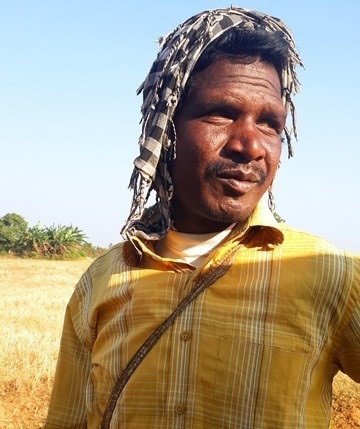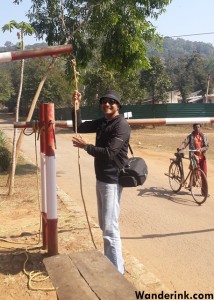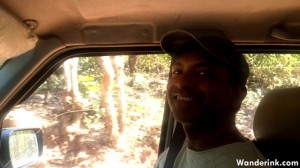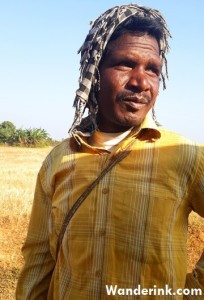Some tough calls are easy to make because we were just waiting, having known all along. I could have stuck to the brief and brought out my book on time. Or I could talk about tribal dislocation, warn about traffic conditions, mull over Maoists, their lives and death and burial traditions, ponder over poaching that went on unhindered in the ‘protected’ biospheres – inviting the sponsor’s wrath and editorial anguish and thereby also bring upon myself the inevitable and frustrating publication delay. Though there is not much to show for it – not an entirely unexpected eventuality for which I had made anticipatory amends through a series of posts – I did opt for the second route. Then I must say surprisingly enough a lot of stuff I laid out expecting to be butchered was retained, quivering Isaacs, thanks to a fantastic edit team at the publishing house who fought a valiant Battle for Editorial Integrity against the might of the allied forces of Misinformation and Myopia.
Was I pandering to a conscience? I was on the road for more than a month working on the guidebook during which I became friends with many people warm, welcoming and remarkably naïve – a trait almost always found at the root of most insurgencies. I believed theirs was a tale which had to be told. Theirs was a culture worthy enough to be documented. Being at loggerheads with authority wasn’t a good enough reason to subject someone to slight or oversight; in fact this very (rebellious) quality made them more intriguing as well as interesting. I met at least two western travellers, including one woman, who was staying with the Gonds and the Baigas, in their homes, keeping a journal of their own experiences and discoveries, their hosts’ convictions and contentions. They weren’t planning on bringing out books but were fully realising the tribal way of living and believing. How I envied them!
Having a dislike bordering on the breathless for guidebooks that are structured so rigid leaving no room for context I wanted to make my guidebook both a guide and a book. I loved the reader and I wanted her to love me back for what I said and how I said it. This made me lace background with humour, intersperse historical perspectives with factious nuggets, people route descriptions with, well, people and ethos. I wanted to show her places she never knew – places that were panting to be uncovered. I was willingly prolix over prosaic, some charged. For others it was facetious and otiose information. But my loyalty lay only with my reader.
While not many venture beyond the salubrious Tibetan settlement Mainpat near Ambikapur, I went to great lengths in every sense to include Dipadih, 80 km north-east, a place I described as ‘possibly the best archaeological site in the state.’ For whatever reason – I was told accessibility – the destination is not promoted the way it should be. This is nothing short of an aggravation. It hurt me and more so the site itself – I witnessed and wrote about a new construction within the site flouting archaeological norms. Need I say that this bit was trimmed.
Reachability should never be a measure of merit, for that matter popularity even. ‘Nobody goes there anyway’ is no reason to relegate a destination further into oblivion. Karkabhat was another site which really caught my fancy. Fearing a similar fate for this prehistoric burial site, I wrote about it on my blog and reviewed it on Tripadvisor to really good response. Centuries from today our blogs might pop up in some kind of cyber excavation and we would want them to be valued for what it is worth, right? Karkabhat made its way into the guidebook, pictures and all; Dipadih, even though is included in the guidebook I will still bring it out next as a post. Because I am sure you too will behold it with the same awe and explore it with the same joy I did. And you may not lay your hands on the guidebook. Travel writers should owe more to the places they write about than to the people who sent them there. Your writing will read better and you will look better that way when your blog and articles come up centuries or many millennia later.
While many place and event have been scissored by the edit team out of their own volition and otherwise there are many that remain untouched by dint of being in my ‘heart and not in the hard drive’ to borrow from a recent commercial. It spoke about the best of memories. Yes, the best of them are always tucked away in our minds till Alzheimer starts chiselling away; the second best are in password-protected folders and drives. The best memories from my 40-day road trip in Chhattisgarh are captured in hastily-shot mobile camera photographs that are burnt or bleary at best.
The laughing tribal / Ambikapur
Cabbies in Ambikapur warned me that the sedan a friend lent me wouldn’t make it to Jashpur via Kailash Gufa and Samarbar with its delightful Sanskrit Mahavidyalaya. The road, as I quoted Robert Fulton Jr. from his book One Man Caravan, is recommended if you are tired of the ‘disadvantages of good roads’ – high speed and the lack of that inspiring factor in travel, the welcoming hand of the interested stranger. Hiring an SUV I set out from Ambikapur through the harshest of roads I encountered in the state save for the 25 km from Baloda Bazaar to Kasdol rigged up by cement factory trucks. The young driver was only too happy to hand over the wheels to me; he went recumbent on the backseat and embarked on an effusion of susurrated amorous assertions broken only when we had to ask for directions.
The tribal in a yellow checked shirt and a sling bag totally ignored me in the driving seat while deferentially giving directions to the driver in the backseat. He reluctantly agreed when I asked him if I could take a photograph and asked a tad irritated why I wanted his photograph. “For memory sake,” I charmed him. As we rolled on I heard a shout from behind and saw the same tribal running after us. Thinking he forgot to collect his baksheesh – as has become the norm of photographic subjects in touristy India – I stopped the vehicle. “Now I understood,” he panted in pidgin Hindi. “You are not the driver, but he is.” He said pointing at the Majnu back on the mobile phone.
He actually ran after us just to share the revelation and a good laugh.
Night safari / Bilaspur
Achanakmar Wildlife Sanctuary is one of the drives from Bilaspur. As with the more popular Barnawapara, here too the animals were playing coy though linked to the large contiguous forest tract that is part of the Kanha-Achanakmar tiger corridor. Tiger sightings were more regular in the part of the reserve that fell in neighbouring Madhya Pradesh. When I whined to the jeep safari boys they rebuked me with a gem: You city dwellers should start considering the jungle as the primary sight in a jungle safari. Being otherwise wonderful, I was invited to go on a midnight outing in the jungle.
Fortified suitably on everything local and potent we set out around 2 AM. We bounced over sandstones, schists and granite outcrops; the ancient Gypsy lights serving to illumine them just in time to grip the anti-roll hard so that I stayed within the vehicle. After an hour of barely missing the sal and saja trees, we reached a waterfall that cascaded down, silky white under a bright moon. Nature was a camera set to very slow shutter speed.
Cockfight / Jagdalpur
Though I have waxed out of whack about the cockfights I saw and went to in the southern Bastar region, even made a short film for YouTube, I still can’t help get over the feeling that I could have made some real dosh had I been a little less cocky. By the time I attended the Chingitarai haat with its scenic cockfight arena with Dokra artisan Hari, I could distinguish a pandri from a chokha and knew to some degree of certainty that agility was more important than strength. Imagine the first few rounds of a kickboxing match but with the combatants wearing spikes. My money was doubled to Rs 1000 in the first go itself – all of which I placed on a bout immediately after returning from a round of celebratory mahua with newfound friends. I still remember the cockle-nuking glee on the face of the withered old man who plucked the note from between my fingers.
First impressions / Raipur
The opening lines on the capital city were crystallised from the observations and experiences, interviews and learning over the course of my stay and travels in the state. Though they didn’t find a place in the final product for reasons of brevity or whatever else, they still remain my impression of the people and the place:
There is an unmistakable sense of urgency in the air. But amidst the cacophony, the confusion and chaos there’s also a sense of change, an eagerness to grab opportunities as well as to pry open new ones. Raipur, like any other capital city, has succeeded in attracting those with immeasurable reservoirs of ambition, the restless ones, those with little time and patience for conventions and beliefs. It is not just the town that is undergoing an elaborate facelift but the entire fabric of the society is being reworked and newer policies framed, alliances struck, promises made. Compromises chalked. Progress has become the buzzword of the capital city of the (now, second) youngest state of the Indian Union. There is the occasional mayhem – a consequence of too much too soon; the lawlessness – appendage of immense prospects and unbending will; there is the confusion and disappointment that comes from impractical goals and monumental dreams. But there is positivity, vibrancy and faith.
And so it went, not very far though.



















